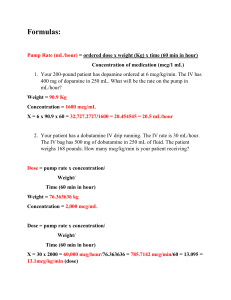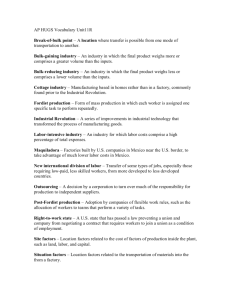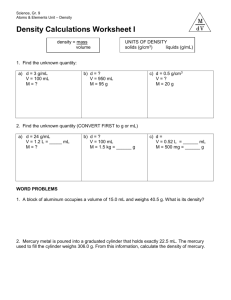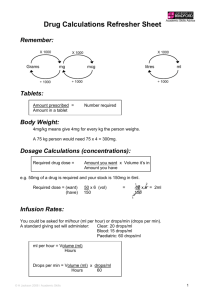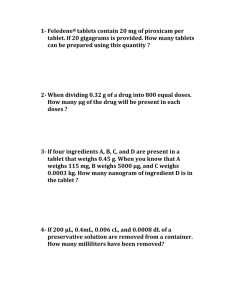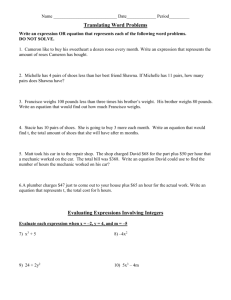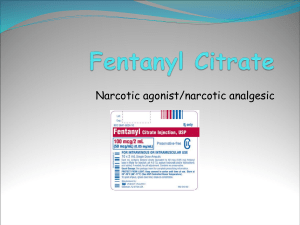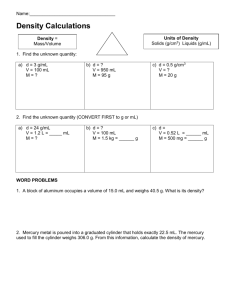Medication Calculation Practice Problems
advertisement
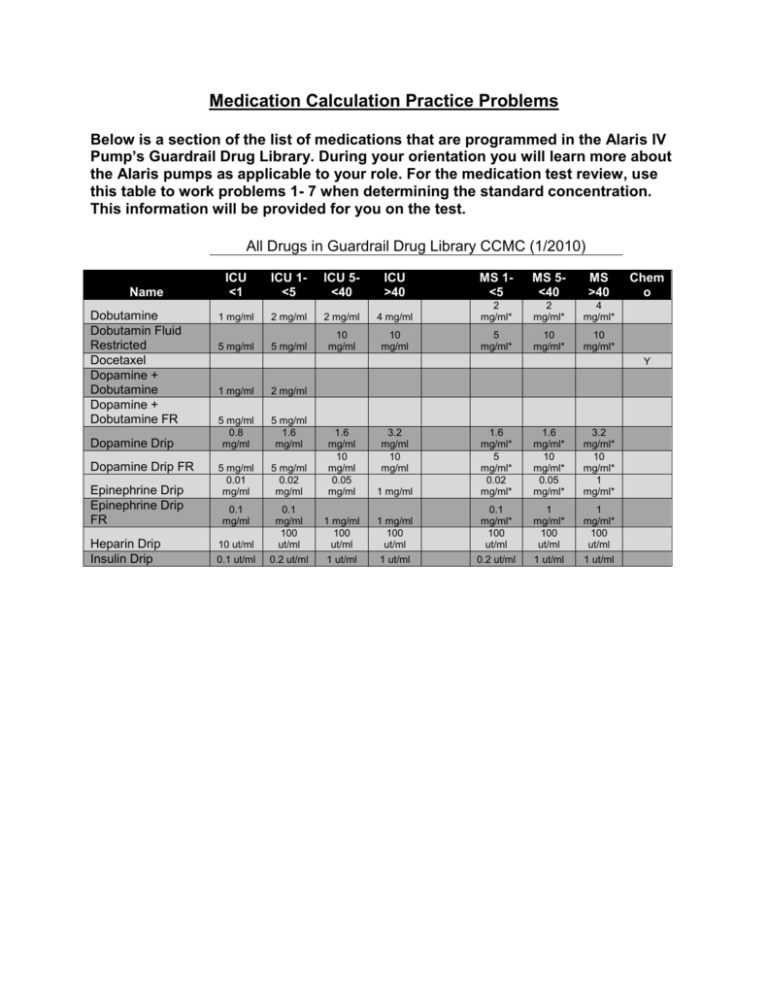
Medication Calculation Practice Problems Below is a section of the list of medications that are programmed in the Alaris IV Pump’s Guardrail Drug Library. During your orientation you will learn more about the Alaris pumps as applicable to your role. For the medication test review, use this table to work problems 1- 7 when determining the standard concentration. This information will be provided for you on the test. All Drugs in Guardrail Drug Library CCMC (1/2010) Name Dobutamine Dobutamin Fluid Restricted Docetaxel Dopamine + Dobutamine Dopamine + Dobutamine FR Dopamine Drip Dopamine Drip FR Epinephrine Drip Epinephrine Drip FR Heparin Drip Insulin Drip ICU <1 ICU 1<5 ICU 5<40 ICU >40 MS 1<5 MS 5<40 MS >40 1 mg/ml 2 mg/ml 2 mg/ml 4 mg/ml 2 mg/ml* 2 mg/ml* 4 mg/ml* 5 mg/ml 5 mg/ml 10 mg/ml 10 mg/ml 5 mg/ml* 10 mg/ml* 10 mg/ml* Chem o Y 1 mg/ml 2 mg/ml 5 mg/ml 0.8 mg/ml 5 mg/ml 1.6 mg/ml 5 mg/ml 0.01 mg/ml 0.1 mg/ml 10 ut/ml 0.1 ut/ml 5 mg/ml 0.02 mg/ml 1.6 mg/ml 10 mg/ml 0.05 mg/ml 0.1 mg/ml 100 ut/ml 0.2 ut/ml 1 mg/ml 100 ut/ml 1 ut/ml 3.2 mg/ml 10 mg/ml 1 mg/ml 1.6 mg/ml* 5 mg/ml* 0.02 mg/ml* 1.6 mg/ml* 10 mg/ml* 0.05 mg/ml* 3.2 mg/ml* 10 mg/ml* 1 mg/ml* 1 mg/ml 100 ut/ml 1 ut/ml 0.1 mg/ml* 100 ut/ml 0.2 ut/ml 1 mg/ml* 100 ut/ml 1 ut/ml 1 mg/ml* 100 ut/ml 1 ut/ml Medication Calculation Practice Problems 1. You have an order for Dobutamine to run at 5mcg/kg/min. The label on the syringe states: Patient Label on Syringe D10 in water injection 50 ml Dobutamine injection 40 mg/ml 100 mg wt 3.54 kg final concentration = Dobutamine 2 mg/ml Your patient weighs 3.54 kg. What is the standard concentration for this patient’s weight? Using your Standard Concentration list, determine the standard concentration. Does this match the concentration listed on the syringe label? Now calculate how many ml will be delivered in an hour (the rate of the pump). Use this formula: ml/hr = (ordered dose) (kg) (time frame) standard concentration available The formula would be: ml/hr = (5 mcg/kg/min) (3.54) (60 min) 2mg/ml NOTE: All units of measure must match. The unit of measure for the ordered dose must match the unit of measure for standard concentration. For example, if the ordered dose is in mg, then the standard concentration must be in mg, if mcg, then mcg, if units, units. The ordered dose time must match the time frame in the equation. If the order is written in min, ex. 5 mcg/kg/min, then the time frame is 60 minutes. If the order is written in hour, then the time frame is 1 hour, ex. 5 units/kg/hr then the time frame is 1 hour. The formula written with matching units would be: ml/hr = (5 mcg/kg/min) (3.54) (60 min) 2000mcg/ml Now solve for the answer. 2. You have an order for Dobutamine to run at 10 mcg/kg/min. Your patient weighs 18 kg. What is the standard concentration for this patient’s weight? How fast will the pump run? 3. You have an order for Insulin to run at 0.08units/kg/hour. Your patient weighs 3.54 kg. What is the standard concentration for this patient’s weight? How fast will the pump run? 4. You have an order for Heparin to run at 10 units/kg/hour. Your patient weighs 4.5 kg. How fast will the pump run? 5. You have an order for Insulin gtt @ 0.01 units/kg/hr. Your patient weighs 22 kg. How fast will the pump run? 6. You have an order for Epinephrine gtt @ 0.1 mcg/kg/min. Your patient weighs 12 kg. How fast will the pump run? 7. You have an order for Dopamine gtt @ 15 mcg/kg/min. Your patient weighs 0.98 kg. How fast will the pump run? 8. A 3100 gram neonate is to receive gentamicin sulfate 5.2 mg IV q 12 h. The vial contains 80 mg/2mL. How many milliliters should be administered for each dose? a. b. c. 9. 0.13 0.31 0.61 A 4 year-old child who weighs 18 kg is to receive 0.1 mg/kg/hour of morphine sulfate via a continuous intravenous infusion. If the intravenous solution contains 1 mg of morphine sulfate per 10 ml, the infusion pump should be set to run at how many milliliters per hour? a. b. c. 0.18 1.8 18 Use the following formula to answer question 10: Formula to calculate a child’s 24-hour fluid maintenance requirement 100 ml/kg for first 10 kg of body weight 50 ml/kg for second 10 kg of body weight 20 ml/kg for each additional kg of body weight 10. A 7 month-old infant who weighs 11 kg is to receive intravenous fluids at 2/3 the maintenance rate. What should be the appropriate hourly rate of the infusion? a. b. c. 29 ml 32 ml 42 ml 11. A 22 month-old child weighing 10 kg is to receive penicillin-G 300,000 units IM. The penicillin-G is available in 5,000,000 units/vial and is to be reconstituted to a concentration of 1,000,000 units/ml. How many milliliters should the child receive? a. b. c. 12. A 5 year-old child who weighs 18 kg is to receive amoxicillin 13.3 mg/kg po q 8h. The medication is available as a liquid containing 250 mg/5 mL. How many milliliters should the child receive with each dose? a. b. c. 13. 0.96 1.9 4.8 A 2 year-old child who has a body surface area (BSA) of 0.63 m2 is to receive 1.5 mg/m2 of a drug. The drug is available in 1 mg/ml vials. How many milliliters should the child receive? a. b. c. 14. 0.03 0.3 3.0 0.68 0.95 1.9 A 4 month-old infant who weighs 7 kilograms has an order for 8 mg of ranitidine po b.i.d.. The recommended dosage range for this medication is 1 to 4 mg/kg per 24 hours. A nurse should recognize that the dosage ordered is a. b. c. within the normal range. lower than the normal range. higher than the normal range. Answers 1. 0.53 ml/hr 2. standard concentration 2mg/ml, 5.4 ml/hr 3. standard concentration 0.2 units/ml, 1.42 ml/hr 4. 0.45 ml/hr 5. 0.22 ml/hr 6. 1.44 ml/hr 7. 1.1 ml/hr 8. a 9. c 10. a 11. b 12. c 13. b 14. a 05/5/2011
